%20(1)%20(1)-png.png)
The beauty of the natural world is not something that is limited to a certain age group, and the inclusiveness of the outdoor community knows no limits. No matter where you spent most of your life, whether you are a home-body or a born nomad, there is no better time to get out into nature than in your senior years.
If you are skeptical about how you would enjoy a hiking adventure while managing the obstacles that come with older age, please continue reading.
This article will guide you through everything you need to know as a senior on how to navigate trails safely, how to use technology to find which trails are best for you and your capabilities, tips for gear and clothing, and more.
Consult with your doctors if hiking is right for you
There are certain medical precautions you must take before exposing yourself to new terrain. And if you are looking to expand your horizons when it comes to longer-distance hiking or more challenging trails, you should still discuss with your doctor what may limit your ability to accomplish your goals and if there are ways around those limitations, such as; quitting smoking, investing in a portable oxygen concentrator, pulmonary rehabilitation programs, a new diet plan etc.

If you struggle with common age related health issues you might find valuable resources online that will help you maintain vitality
Common age related health issues that may affect your ability to hike develop in your bones, heart, and lungs. If you experience any of these complications, it does not mean that this is the end to your hiking endeavors. All this means is that you are going to start your uphill battle before hitting the trail.
Health issues that make it too difficult to hike
COPD is one of the most common lung aliments and it will progress into a very serious condition if gone untreated.
That being said, we do understand the reality that some people's health conditions does inhibit their ability to hike safely and comfortably. However, walking is one of best things you can do for COPD, and other health complications like osteoporosis, or heart failure.
Try pushing yourself to walk around your house once a day: walk to get the mail, or go up and down the stairs. From there your lungs, bones, and heart will begin to strengthen and hopefully your energy levels will increase allowing you to go further everyday, and potentially get outside on a trail someday.
{{cta('43b79c5e-6bd6-4f02-ac27-2d038d20c146','justifycenter')}}
Begin a hiking training program at home
If you are healthy and ready to start mapping out your next adventure, skip to the next section! Otherwise, begin implementing a strict exercise, weight management, and diet plan into your daily routine. Start your training by walking daily for a week and write down in a journal your route, distance, amount of time, and details about how you felt and anything you noticed about your body or experience.
You can try to share your stats and observations with your future hiking buddies or family to reinforce your efforts. Keeping a record can be very self gratifying because hiking can become addictive!
You should also enforce a strict diet plan that is high in nutrients your body craves. Talk to a nutritionist about foods you can start incorporating into your diet, so you are more capable of building strength and endurance for the trail.
Strengthen your core
To walk for hours at a time, do not be fooled, you’ll need more than just strong legs. Distance walking has been proven to compress your spine, causing backaches. One way to minimize back pain or aches while hiking or long distance walking is to focus on building core strength.
While you are walking, always try lengthening your spine by keeping your shoulders down, abdomen (stomach) contracted into your spine, keep your head held high, and avoid staring straight down at the ground. You can also try swimming, water aerobics, pilates and yoga to help build your core and keep you limber.
It is completely normal to lose muscle mass as you age, but you are able to tone the muscle you do have by incorporating cross training exercise with your hiking and long distance walks such as: Downward dogs and planks from yoga, Cardio from water jogging and aerobics, and crunches and even gardening for extra core work.
Download the AllTrails app on your apple or android smartphone
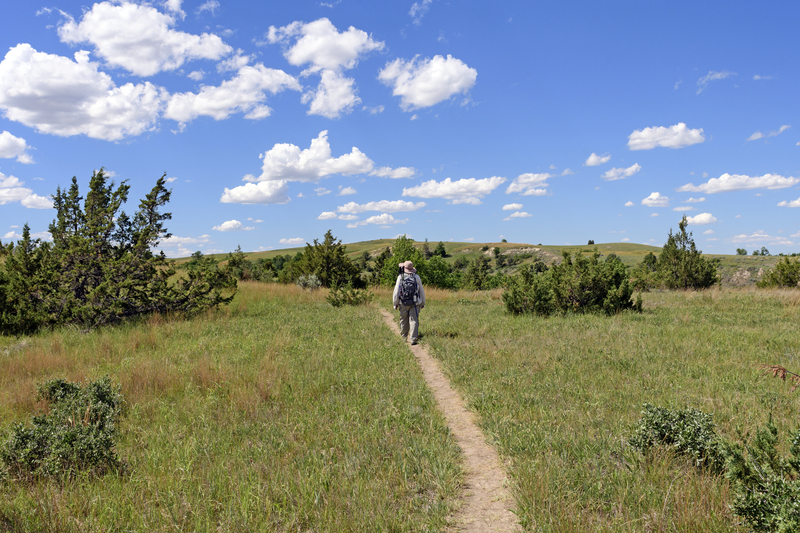
AllTrails will act as your guide if you do not want to hire a guide or go hiking with a tour group. While the latter options are great, some individuals value independence on the trail and in the wilderness.
This app is simple and easy to use, you can find trailheads near your area and far beyond, and you can use the app while you are hiking as a map so you stay on the trail and don't get lost.
You are able to use GSP and find hikes near you, or input a nearby town or mountain range you are looking to explore. You can filter the results by the “Best Match”, “Most Popular”, or the “Closet”, and you can choose ''Easy”, “Moderate”, to “Difficult” trails.
The app will also only show you the trails that are a specified distance, so if you only want to go 1.5 miles one day, you are capable of finding a trail that's perfect for you.
AllTrails will also inform you of the hiking trails that offer mountain biking, dog, horseback riding, or motorized vehicles, so you will be aware of all the faster moving obstacles you might encounter.
The most useful AllTrails feature for seniors or people with disabilities or health conditions is the option to filter trail results that are wheelchair friendly and paved or partially paved. Also by being able to input elevation gain, you can find flat trails that you can wheel your continuous flow oxygen concentrator or feel confident carrying a portable oxygen concentrator with ease.
Choose the trail that is right for you
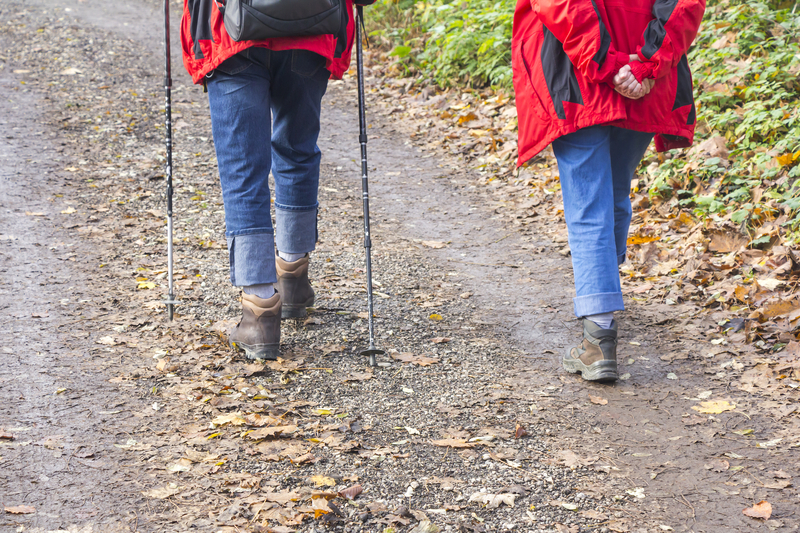
Now that you have an essential application (AllTrails) for choosing the right trail, it is time to be honest with yourself, and decide what hike is within your capabilities. It is perfectly normal to start small: Take a short 0.7 mile hike, that is partially paved, and close by your home.
Hiking trails that are good for seniors who do not normally hike are typically flatter and wider. If you are a beginner stick to a trail with a smooth walking surface that is better for balance and try to avoid trails with higher elevation gain.
Hiking uphill can be strenuous for your lungs, while hiking downhill can be rough on your knees.
Once you begin to feel more comfortable on the trails, you can start poking around your comfort zone, but never feel obligated to be uncomfortable, hiking should be a stress reliever, and if you are feeling dread or fear over a hike you planned, it is not the best option for you at that time.
Check the weather in the nearby town or area
If you are about to embark on your adventure in the woods, along the beach, through the plains, or along foothills be sure to check the weather in the nearby town before you go. Be aware that the weather at higher elevation tends to change rapidly and with little to no warning.
Know as much as you can about the weather patterns in the area before you go so that you can pack all of the essentials: rain coat, wind breaker, sunscreen, sun hat, or insulated jacket.
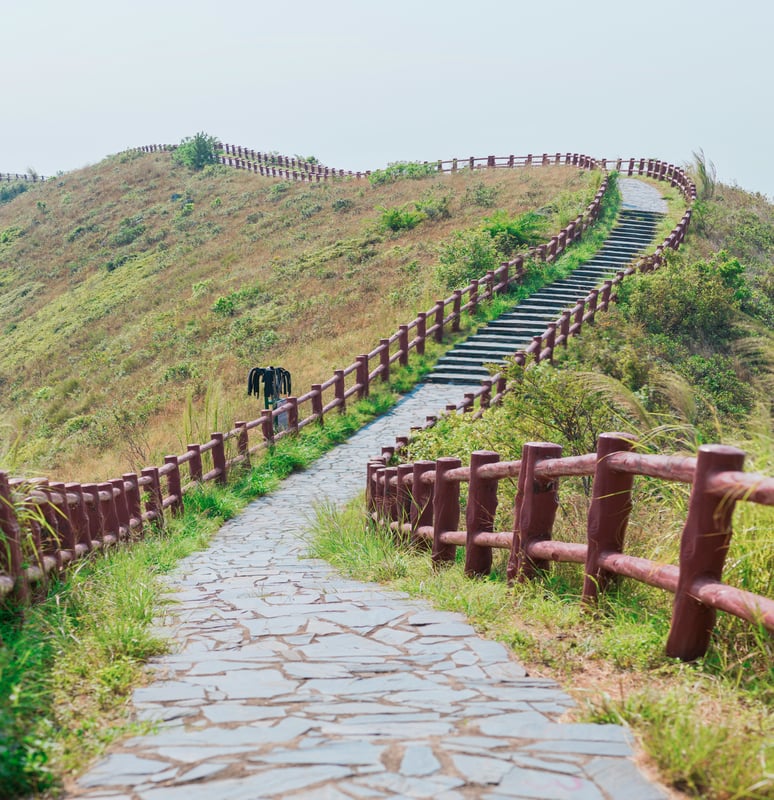
Dress for the weather
The best advice for hiking clothing is to wear or bring multiple layers. Going up hill you may feel warm, and going down hill you might get chilly. Weather will also change through out the day so you are able to de-layer or add layers whenever necessary for your ultimate comfort. Here are some ideas for outerwear options in different weather conditions:
Early morning hike in the middle of July:
-
Light/ medium jacket: The morning air may be chilly especially if you are in the mountains or exploring in higher elevations
-
Breathable hiking pants: While it may be chilly in the mornings, towards the middle and end of your hike the sun will kick in and having breathable pants will make a world difference. You will want to avoid wearing shorts to limit bug bites and exposure to harmful UV sun rays
-
Sun hat: Invest in a hat that covers your forehead, ears, and neck. Even by applying sunscreen to these areas, your forehead and neck will likely sweat during the hike and if you forget to reapply sunscreen the sun damage can be irreversible.
Afternoon hike to see the leaves changing at the beginning of Autumn:
-
Base layer: Your base layer should not be cotton fabric. You will likely sweat on the way up the trail, and rather than wicking away perspirant, cotton will trap moisture keeping you cold and wet on the way down.
-
Insulated rain coat: Even if there is no rain in the forecast, an insulated raincoat will keep you warm all the way up and down the trail, and if an unexpected afternoon storm rolls in you’ll be prepared.
-
Hiking pants: Hiking pants that are comfortable yet warm will be perfect for an Autumn hike. If you walk at a steady pace, you don't want to get too hot by wearing an extra base layer.
A sunny but wintery hike for a chance to get outside before the next storm rolls in
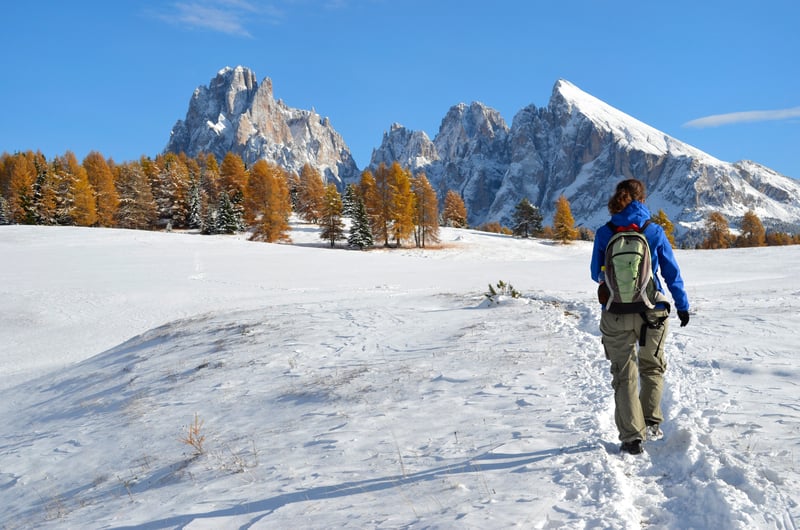
-
Base layer: Your base layer should not be cotton fabric. You will likely sweat on the way up the trail, and rather than wicking away perspirant cotton trap moisture, keeping you cold and wet on the way down.
-
Breathable sweater: A mild sweater will keep you warm if you are too warm wearing the puffy coat and you want to de-layer
-
Puffy coat: The best way to stay warm in cold temperatures is to have a down or synthetic down puffy coat. These will also fold down small enough to stuff in your backpack when you start to warm up and need to de-layer.
-
Base layer pants: water wicking pants with some insulation will keep your extremities warm through, snow, wind, and cold temperatures.
-
Hiking pants: Wearing thick hiking pants will protect you against cold winds while still allowing maneuverability
A hike across the valley to see the annual spring blooms
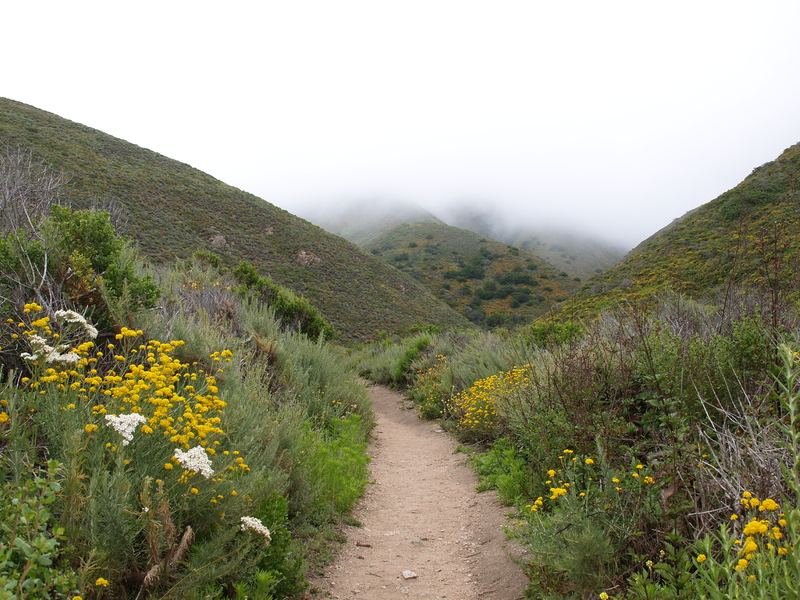
-
Base layer: Your base layer should not be cotton fabric. You will likely sweat on the way up the trail, and rather than wicking away perspirant, cotton trap moisture keeping you cold and wet on the way down.
-
Light rain jacket: A light rain jacket will keep you dry if there are any showers but won’t insulate heat so you won’t get too hot.
- Hiking pants: Pants are always the best options for protection against rain, wind, and sun.
Use trekking/hiking poles
Hiking poles are a great option for hikers of all ages because they help immensely with balance. Poles can be used to lighten your steps, ease your knees, help propel you forward, help you detect a path’s surface, and test wobbly rocks.
You should train to use your trekking poles before you get on the trail to develop efficiency and to gain arm strength. When you are buying trekking/hiking poles, remember that most hiking poles are adjustable so you are able to shorten the poles for the hike up and lengthen them for the way down.
Drink plenty of water
Having enough water is the key to enjoying physical activities, especially outdoors while hiking. One trick to getting enough water and staying hydrated is to drink plenty of water a couple of days before you plan to go hiking so your body is already fueled and hydrated before your hike.
If you are going on a longer hike, bring a camelback backpack, and a water pump to filter running water in case you run out. This should on be necessary for very experienced hikers going very far distances upwards of 6-10 miles, with high-levels of elevation gain.
A 24 fl oz water bottle should do the trick for a mile long hike, unless it's mid-day, June-August, and hot, you should bring at least two water bottles and place them in the side pockets of your backpack.
If carrying water is too heavy, hydrate a lot the week before you go hiking, drink a full bottle of water on the drive to the hike, carry a smaller light weight water bottle for sipping during the hike, and leave an entire water bottle full in the car for afterwards.
Pack a first aid or emergency kit
Even if you are just going for a short hike, you should always bring a first aid kit especially if you have any health conditions. This can be a makeshift first aid kit, with all of your personal essentials like an inhaler or nebulizer, or if you do not have any health condition, you can find a small first kit at any general store.
If you are embarking on a longer more strenuous journey, pack an emergency kit with an outdoor first aid kit, extra food and water, a way to start a fire (like waterproof matchers or a lighter), and always bring a headlamp or flashlight.
{{cta('fa8abc2a-1e88-4fa3-82fd-1cb5b9ed43b2','justifycenter')}}
Hike with a group
Some people enjoy the isolation of being out in nature alone, but if you have any underlying health conditions, it is important to have people who can help you if something goes astray.
Try finding a buddy or two who enjoy the outdoors, and are willing or able to maintain your hiking pace. It is not always fun leaving your group behind or feeling rushed and overwhelmed being in the back of the group.
There is nothing wrong with finding your pace, and sticking to it, but a healthy group dynamic while hiking keeps morale high.
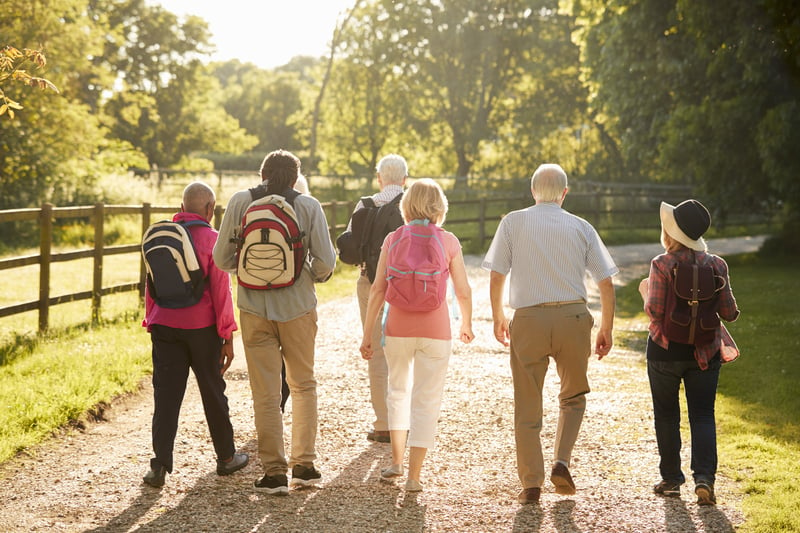
Enjoy the views
We hope that everyone can find some outdoor adventure that suits their needs, and we hope to give you the tools to navigate the outdoors with ease and confidence going forward.
If you enjoyed this article keep following us for upcoming posts about outdoor recreation for seniors or anyone with a health condition that might feel limited in their ability to do outdoor activities.
If you would be interested in hearing about hikes near you, please leave a comment below and a note about your capabilities so we can research ideas for your next adventure and write about it in out next blog post.
Remember there is no right or wrong way to hike, as long as you are safe responsible and enjoying your time outdoors!

